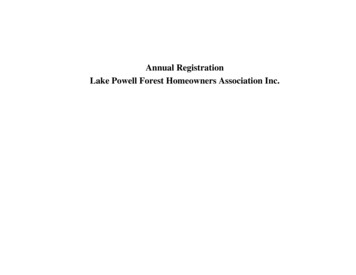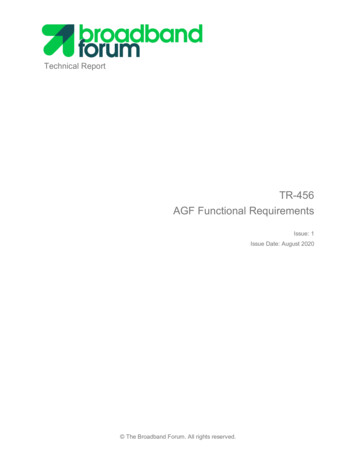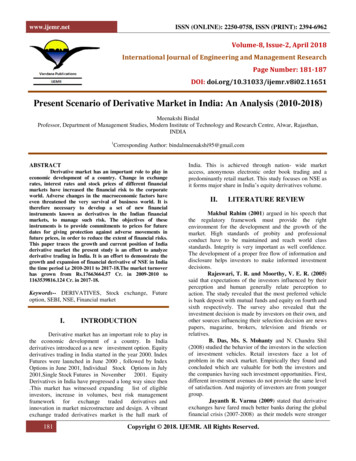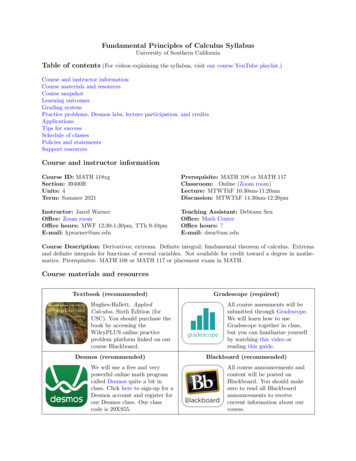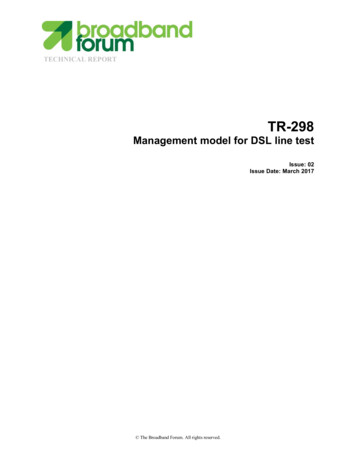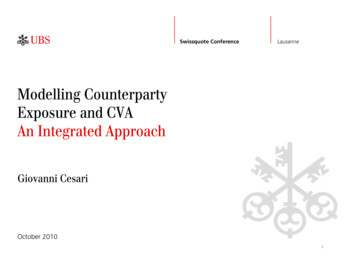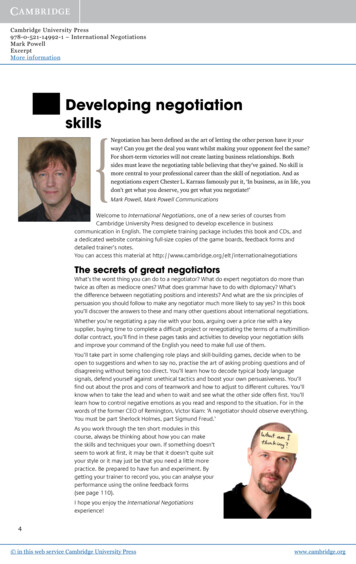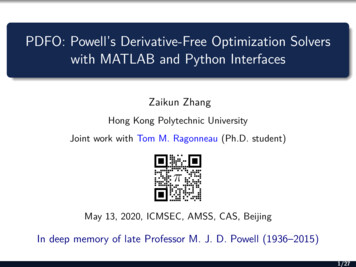
Transcription
PDFO: Powell’s Derivative-Free Optimization Solverswith MATLAB and Python InterfacesZaikun ZhangHong Kong Polytechnic UniversityJoint work with Tom M. Ragonneau (Ph.D. student)May 13, 2020, ICMSEC, AMSS, CAS, BeijingIn deep memory of late Professor M. J. D. Powell (1936–2015)1/27
Why optimize a function without using derivatives?I started to write computer programs in Fortran at Harwell in 1962. . after movingto Cambridge in 1976 . I became a consultant for IMSL. One product they receivedfrom me was the TOLMIN package for optimization . which requires first derivatives. Their customers, however, prefer methods that are without derivatives, so IMSLforced my software to employ difference approximations . I was not happy . Thusthere was strong motivation to try to construct some better algorithms.— PowellA view of algorithms for optimization without derivatives, 20072/27
Derivative-free optimization (DFO) Minimize a function f using function values but not derivatives. A typical case: f is a black box without an explicit formula.xff(x) Here, the reason for not using derivatives is not nonsmoothness! Do not use derivative-free optimization methods if any kind of(approximate) first-order information is available. Regarding your problem as a pure black box is generally a bad idea. It ismore often a gray box. Any known structure should be explored.3/27
DFO is no fairy-tale world The black box defining f can be extremely noisy.12Fairy taleReality108642-3-2-10123(Yes, this is your favorite convex quadratic function) The function evaluation can be extremely expensive. The budget can be extremely low.(In real applications) . one almost never reaches a solution but even 1% improvement can be extremely valuable.— ConnInversion, history matching, clustering and linear algebra, 20154/27
About the name(s) Talking about optimization methods that do not use derivatives, Powellcalled them direct search optimization methods or optimization withoutderivatives, but never derivative-free optimization. These days, “direct search methods” refers to a special class of methods. Problems that only provide function values are often categorized asblack-box optimization or simulation-based optimization.5/27
Applications Colson, et al., Optimization methods for advanced design of aircraftpanels: a comparison, 2010. Ciccazzo, et al., Derivative-free robust optimization for circuit design,2015 Wild, Sarich, and Schunck, Derivative-free optimization for parameterestimation in computational nuclear physics, 2015 Campana, et al., Derivative-free global ship design optimization usingglobal/local hybridization of the direct algorithm, 2016 Ghanbari and Scheinberg, Black-box optimization in machine learningwith trust region based derivative free algorithm, 20176/27
No applications by Powell, because .The development of algorithms for optimization has been my main field of researchfor 45 years, but I have given hardly any attention to applications. It is very helpful,however, to try to solve some particular problems well, in order to receive guidancefrom numerical results, and in order not to be misled from efficiency in practice bya desire to prove convergence theorems. . I was told . that the DFP algorithm(Fletcher and Powell, 1963) had assisted the moon landings of the Apollo 11 SpaceMission.— PowellA view of algorithms for optimization without derivatives, 20077/27
Well-developed theory and methods Powell, Direct search algorithms for optimization calculations, 1998 Powell, A view of algorithms for optimization without derivatives, 2007 Conn, Scheinberg, and Vicente, Introduction to Derivative-FreeOptimization, 2007 Audet and Warren, Derivative-Free and Blackbox Optimization, 2017 Larson, Menickelly, and Wild, Derivative-free optimization methods,20198/27
Two classes of methods Trust-region methods: iterates are defined based on minimization ofmodels of the objective function in adaptively chosen trust regions.- Examples: Powell’s methods are trust-region method based on linearor quadratic models built by interpolation. Direct search methods: iterates are defined based on comparison ofobjective function values without building models.- Examples: Simplex method (Nelder and Mead, 1965), ImplicitFiltering (Gilmore and Kelley, 1995), GPS (Torczon, 1997), MADS(Audet and Dennis, 2006), BFO (Porcelli and Toint, 2015), 9/27
Basic idea of trust-region methodsxk 1 xk argmin mk (xk d) d k mk is the trust-region model and mk (x) f(x) around xk .- When derivatives are available: Taylor expansion or its variants(Newton, quasi-Newton, .)- When derivatives are unavailable: interpolation/regression- Applicable in nonsmooth case: Yuan (1983 and 1985), Grapiglia,Yuan, Yuan (2016) d k is the trust-region constraint. k is the adaptively chosen trust-region radius. xk 1 may equal xk . I am abusing the notation argmin (in multiple ways).10/27
Trust-region frameworkAlgorithm (Trust-region framework for unconstrained optimization)Pick x0 Rn , 0 0, 0 η1 η2 1, η2 0, and 0 γ1 1 γ2 . k : 0.Step 1. Construct a modelmk (x) f(x)aroundxk .Step 2. Obtain a trial step dk by solving (inexactly)min d kStep 3. Evaluate the reduction ratio ρk xk 1{xk x k dkif ρk η1,if ρk η1mk (xk d).f(xk ) f(xk dk ), and setmk (xk ) mk (xk dk ){ γ1 kif ρk η2 k 1. [ k , γ2 k ] if ρk η2Increment k by 1. Go to Step 1.Typical parameters: η1 0, η2 1/10, γ1 1/2, γ2 2.Note: The framework needs to be adapted if derivatives are unavailable.11/27
An illustration of trust-region methodAn illustration of trust-region method11Images by Dr. F. V. Berghen from http://www.applied-mathematics.net.12/27
An illustration of trust-region methodAn illustration of trust-region method11Images by Dr. F. V. Berghen from http://www.applied-mathematics.net.12/27
An illustration of trust-region methodAn illustration of trust-region method11Images by Dr. F. V. Berghen from http://www.applied-mathematics.net.12/27
An illustration of trust-region methodAn illustration of trust-region method11Images by Dr. F. V. Berghen from http://www.applied-mathematics.net.12/27
An illustration of trust-region methodAn illustration of trust-region method11Images by Dr. F. V. Berghen from http://www.applied-mathematics.net.12/27
An illustration of trust-region methodAn illustration of trust-region method11Images by Dr. F. V. Berghen from http://www.applied-mathematics.net.12/27
Powell’s algorithms and Fortran solvers (I)Powell’s second paper on optimization:Powell, An efficient method for finding the minimum of a function ofseveral variables without calculating derivatives, 1964 It is also Powell’s second most cited paper (4991 on Google Scholar asof May 13, 2020). The method is known as Powell’s conjugate direction method. Powell did not release his own implementation.13/27
Powell’s algorithms and Fortran solvers (II) COBYLA: solving general nonlinearly constrained problems using linearmodels; code released in 1992; paper published in 1994 UOBYQA: solving unconstrained problems using quadratic models; codereleased in 2000; paper published in 2002 NEWUOA: solving unconstrained problems using quadratic models;code released in 2004; paper published in 2006 BOBYQA: solving bound constrained problems using quadratic models;code released and paper written in 2009 LINCOA: solving linearly constrained problems using quadratic models;code released in 2013; no paper written Maybe COBYQA in heaven .14/27
Quadratic models in UOBYQA UOBYQA maintains an interpolation set Yk and decides mk bymk (y) f(y),y Yk . The above condition is a linear system of the coefficients of mk . In Rn , Yk consists of O(n2 ) points. (Why?) Most points in Yk are recycled. Yk 1 differs from Yk by only one point. It is crucial to make sure that Yk has “good geometry”. Normally, UOBYQA cannot solve large problems. UOBYQA may solve large problems by parallel function evaluations.15/27
Quadratic models in NEWUOA, BOBYQA, and LINCOAUnderdetermined interpolation with much less function evaluations:min 2 mk 2 mk 1 Fs.t. mk (y) f(y),y Yk . In general, Yk O(n). The idea originates from the least change properties of quasi-Newtonmethods, of which DFP was the first one. The objective can be generalized to a functional F measuring theregularity of a model m. For instance:F(m) 2 m 2 mk 1 2F σk m(xk ) mk 1 (xk ) 22 .See Powell (2012) and Z. (2014).16/27
Capability of Powell’s solversPerhaps foremost among the limitations of derivative-free methods is that, on aserial machine, it is usually not reasonable to try and optimize problems withmore than a few tens of variables, although some of the most recent techniques(NEWUOA) can handle unconstrained problems in hundreds of variables.— Conn, Scheinberg, and VicenteIntroduction to Derivative-Free Optimization, 2007LINCOA is not suitable for very large numbers of variables because no attention isgiven to any sparsity. A few calculations with 1000 variables, however, have beenrun successfully overnight .— PowellComments in the Fortran code of LINCOA, 201317/27
PDFO: MATLAB/Python interfaces for Powell’s solvers Powell’s Fortran solvers are artworks. They are robust and efficient. Not everyone can (or has the chance to) appreciate artworks. Less and less people can use Fortran, let alone Fortran 77. PDFO provides user-friendly interfaces for calling Powell’s solvers. PDFO supports currently MATLAB and Python. More will come. PDFO supports various platforms: Linux, Mac, and even Windows. PDFO is not MATLAB/Python implementations of Powell’s solvers.PDFO homepage: www.pdfo.net18/27
Bayesian optimization Regard f as a Gaussian process (i.e., it is a considered as a function thatreturns random values). Start with a prior model (aka, surrogate) f0 of f. At iteration k, using the data Dk up to now to update the model of f,obtaining a posterior model fk of f :fk posterior of f given prior fk 1 and information Dk . Based on fk , define an acquisition function u(· Dk ) (e.g., expectedimprovement). Letxk 1 argmin u(x Dk ).x Observe (i.e., evaluate) f at xk 1 , obtaining yk 1 , and updateDk 1 Dk {(xk 1 , yk 1 )}. Iterate the above procedure.19/27
Many advantages of Bayesian optimization Little assumption on the objective function (if any). Can handle general variables (continuous, integer, categorical, .). Designed for global optimization (in theory .). The idea is easy to understand and attractive (this is important!). Popular among engineers (being popular is surely an advantage!).20/27
Comparison I: A synthetic noisy smooth problemChained Rosenbrock function (Powell, 2006):f(x) n 1 [4(xi 1 x2i )2 (1 xi )2 ].i 1Observed value:F(x) f(x)[1 σe(x)],where e(x) is a random variable that follows either U([ 1, 1]) or N(0, 1).In our experiments: dimension: n 10 constraints: 10 xi i, i 1, 2, . . . , nnnoise level: σ 0.1starting point: mid point between lower and upper boundsbudget: 100 function evaluationsBayesian optimizer: function bayesopt in MATLABnumber of random experiments: 2021/27
Uniform noise10 5bobyqacobylabayesopt10 410 310 210110 002040608010022/27
Gaussian noise10 5bobyqacobylabayesopt10 410 302040608010023/27
Comparison II: A synthetic noisy nonsmooth problemA Rosenbrock-like nonsmooth function:f(x) n 1 (4 xi 1 x2i 1 xi ).i 1Observed value:F(x) f(x)[1 σe(x)],where e(x) is a random variable that follows either U([ 1, 1]) or N(0, 1).The settings of the experiment are the same as the smooth case.Note:Powell’s solvers are not (particularly) designed for nonsmooth problems.No theoretical guarantee about the behavior of the solvers in such ascenario.24/27
Uniform noisebobyqacobylabayesopt10 310 210 102040608010025/27
Gaussian noisebobyqacobylabayesopt10 310 202040608010026/27
Summary Basic ideas of Powell’s derivative-free optimization solvers PDFO: MATLAB/Python interfaces for Powell’s Fortran solvers A brief comparison with Bayesian optimizationThank you!zaikun.zhang@polyu.edu.hkPDFO homepage: www.pdfo.net27/27
Applications Colson, et al., Optimization methods for advanced design of aircraft panels: a comparison, 2010. Ciccazzo, et al., Derivative-free robust optimization for circuit design, 2015 Wild, Sarich, and Schunck, Derivative-free optimization for parameter estimation in computational nuclear physics, 2015 Campana, et al., Derivative-free global ship design optimization using

